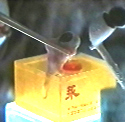 |
<< previous film | next film >>
General Information:
| Year Released: |
1982 |
| Country: |
US |
| Director: |
Ridley Scott |
| IMDB: |
http://us.imdb.com/Title?0083658 |
| Literary Source: |
Philip K. Dick, Do Androids Dream of Electric Sheep? |
|
|
|
Blade Runner is a film that completely embodies almost every category of science and technology. Everything in this film is high-tech -- from the 200 story buildings to the talking billboards which float in the sky. Technology is deeply embedded in everything that is said and done; it is habitual and taken for granted. Deckard controls his computer with voice commands and rides in a police car which flies through the air, but all of this is perfectly normal. The billboards talk and nobody questions it. Making a telephone call on an audio-visual payphone is not unusual. The city of Los Angeles has expanded upwards in addition to outwards.
The way that technology is implemented in this film is highly believable, largely because of how dirty it is. Instead of being squeaky-clean, friendly, and the savior of mankind, it also has a very negative side. One of the side-effects of high technology is pollution, which is constantly shown. During the second opening sequence, the camera follows a car as it flies over the city, passing through the thick smog of industry.
Due to man's abuse of the planet, animal life has been virtually eliminated. Genetically engineered artificial animals appear throughout the film. Most notable are the owl and the snake. The owl is a pet of Tyrell's, and it appears whenever he does. The snake belongs to Zhora. We are first introduced to it through its scale, which Deckard finds in Leon's apartment. By following Deckard as he tracks the scale to the woman's snake, we learn a little bit about the culture of animal manufacturing.
|
The Promise of Science: Man Made Life
|
The boundaries between human and not human are almost nonexistent in Blade Runner. The replicants in this film are so similar to humans that the only way to tell a human from a replicant is by administering a Voight-Kampf test, which looks for telltale signs of emotional response in a person's eye. Emotional or empathetic response is what defines humanity in the world of this film, and this is provided to humans through a lifetime of experiences and memories.
Rachel, one of the latest and most human-like replicants, believes she is human until proven otherwise. She is perhaps the most emotional character in the entire film. This is because she has implanted memories (those of Tyrell's niece) that help form emotional response.
Similar to the creations of Dr. Moreau, replicants have been created as slaves and servants through a combination of genetic engineering and manufacturing. They are created with super-human traits that match their functionality; therefore, combat models are stronger and faster than humans. Most often, they are used for the dangerous task of exploring and colonizing new worlds.
Replicants have been outlawed on Earth, because humans were made nervous by the idea of being eclipsed by their own creations. A group of highly advanced Nexus 6 replicants revolted and escaped from a colony in deep space, and have returned to earth to reconcile their existence. They believe that they are just as alive as humans are, and have every right to live a full life. As the film progresses, these replicants display more and more emotions, ultimately displaying more humanity than Deckard.
At the end of the film, Roy (the lead replicant) saves Deckard's life and points out that humans are again in the business of slavery. We are left questioning whether Deckard is really human, or if he is an advanced replicant with memory implants.
|
 |

Eyes are a recurring theme in this film. It is by examining the eyes that one's human status is determined. This is an artificial eye, used to create replicants. |
|
<< previous film | next film >>
|
 |




